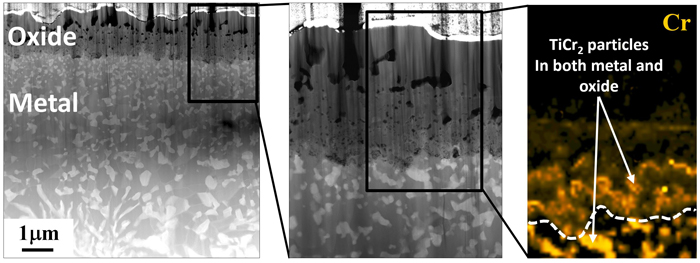Significance Statement
In this research it is sought to develop a combinatorial approach to rapidly investigate effect of Cr content on the high temperature oxidation behavior of titanium. It should be noted that there are many high temperature structural applications where use of titanium alloys is desirable owing to their attractive combination of properties however, associated inherent shortcomings (e.g. low oxidation resistance) have limited their use. This work systematically explores the composition space (across a wide range) with regard to the oxidation response of titanium including: mechanisms associated with evolution of the oxide scale and the effect of oxygen ingress on the microstructure of the base metal. This is somehow neglected in the majority of efforts spent to study the oxidation of titanium alloys due to the difficulties associated with the experimental designs including: achievement of the intended composition, repeatability of the experiments, time and the monetary commitment in addition to the large number of experiments that must be carried out. This approach overcomes the aforementioned difficulties, breaks down the sheer number of factors, eliminates the experimental variabilities as the potential source of error and reveals the role of an individual element on the oxidation response of titanium at high temperature.
A compositionally graded model system Ti-xCr is produced and carefully characterized to assess several aspects of the oxidation reaction as a function of local average composition including: the operating oxidation mechanisms; the structure and composition of the oxides; the oxide adherence and porosity; the thickness of the oxide layers; the depth of oxygen ingress; and microstructural evolution of the base material. A thermodynamic framework was also used to rationalize the oxygen-induced subsurface microstructural transformations.
Journal Reference
Corrosion Science, Volume 97, 2015, Pages 150–160.
Peyman Samimi1,2, Yue Liu1,2, Iman Ghamarian1, David A. Brice1 , Peter C. Collins1,2
[expand title=”Show Affiliations”]- Department of Materials Science and Engineering and the Center for Advanced Research and Testing, University of North Texas, Denton, TX 76203, USA
- Center for Advanced Non-Ferrous Structural Alloys, an NSF-I/UCRC between the University of North Texas (Denton, TX) and the Colorado School of Mines (Golden, CO), United States
Abstract
Poor oxidation performance of Ti-based alloys is an important life-limiting factor for high temperature applications. In this paper, a combinatorial approach is used to investigate systematically the influence of composition and time on the oxidation of Ti–Cr system. A compositionally graded Ti–xCr specimen (0 ⩽ x ⩽ 40 wt%) was prepared and oxidized at 650 °C. The structure and composition of the oxide and near-surface region were studied and a critical composition of ∼20 wt% Cr was identified above which the oxidation resistance is enhanced. Below the critical composition transition to a rapid breakaway oxidation was observed for extended exposure times.
Go To Corrosion Science
Figure Legend: The STEM micrographs of the cross-section morphology of a Ti-24Cr alloy oxidized for 25hr at 650°C and the corresponding STEM-EDS Cr concentration map.
 Advances in Engineering Advances in Engineering features breaking research judged by Advances in Engineering advisory team to be of key importance in the Engineering field. Papers are selected from over 10,000 published each week from most peer reviewed journals.
Advances in Engineering Advances in Engineering features breaking research judged by Advances in Engineering advisory team to be of key importance in the Engineering field. Papers are selected from over 10,000 published each week from most peer reviewed journals.


